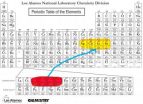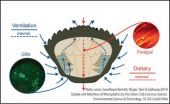(Press-News.org) The world is mostly neutral. That is, most of the atoms in our environment are electrically neutral. The number of electrons in the outer parts of atoms equals the number of protons at the centers of atoms. As one or more electrons are plucked away from the atoms, the remaining electrons feel a much stronger positive pull from the nucleus. This enhanced pull, causing the atoms to shrink in size, ensures that those electrons are less vulnerable to the distractions of their environment, making them potentially valuable for next-generation atomic clocks, for quantum information schemes (where the loss of quantum coherence in qubits is a paramount danger), and for experiments trying to detect slight variations in the fine structure constant, the parameter that sets the overall strength of the electromagnetic force.
A new theoretical study conducted by JQI adjunct fellow Marianna Safronova and her colleagues from groups around the world (1) provides the best yet study of how highly charged ions could be used for atomic timekeeping and for processing quantum information. They identify 10 such ions---for instance, samarium-14+ and neodymium-10+---along with estimates of ion properties experimenters need to know before beginning their work, things such as the expected lifetimes and internal energy levels for the excited states of the ions.
WORKING WITH HIGHLY CHARGED IONS
Charged-up atoms are hard to produce and control. At one of the facilities dedicated to this purpose, the Electron Beam Ion Trap (EBIT) at the Lawrence Livermore National Lab, a beam of electrons intercepts a beam of atoms, ionizing the atoms at they go. In this way charge states all the way up to +92 (fully ionized uranium atoms) have been achieved. The trick is to store such charged ions and to cool them to low temperatures. In the kind of atomic environments typical of atomic clocks or quantum computers, low temperature means small ion motion, which makes for better spectroscopy.
Spectroscopy, the measurement of the energy of atomic transitions, is all important for the applications mentioned above---clocks, quantum computing, and testing the constants of nature. Currently the world's time standard is pegged to a particular microwave transition in cesium-133 atoms.. Even higher precision and better clocks will result from the use of transitions in the optical range.
One problem of working with highly charged ions is that the gaps in the energy levels are too great. This is because when you ionize an atom, its energy levels get further apart. The light emanating from transitions in these ions is at too great a frequency, often in the ultraviolet part of the electromagnetic spectrum. Precision control and manipulation of ions needed for clocks and quantum information is harder or presently impossible to do in that UV or even x-ray energy regime. So in choosing ion candidates, it is important to search for transitions in the optical or near-optical range.
Another criterion is that the ions should be able to attain semi-stable excited states. A third criterion is that the characteristic transition is not between the states from the same electronic configuration. Such transitions do not have enhanced sensitivity to the study whether the fine structure constant is changing over time.. A fourth criterion is that the final ionic state should not be a radioactive substance, thus reducing handling problems.
Safronova and her colleagues, using these criteria and a state-of-the-art methods that they developed to study atoms arrived at their list of ten worthy ion species. They publish their results in the 18 July 2014 issue of Physical Review Letters (2).
Not the least part of their achievement is the authors' specification of the frequencies to be expected from the critical transitions in the candidate ions. It's hard enough to calculate the transition energies of un-ionized atoms, but even harder with these particular highly charged ions. They calculated the frequencies for their select ions and then compared (where appropriate) with the values observed in the lab. The difference, generally less than 1%, should reassure experimenters that Safronova and her colleagues can accurately predict properties of ions where no experimental data are available. .
CLOCKWORK
The use of highly charged ions might result in more accurate clocks since the atoms will be more immune from interference from nearby electric or magnetic fields. But aren't atomic clocks already good? They are. In January 2014, physicists at NIST-Boulder announced the creation of an atomic clock that sets records for accuracy and stability, at the 6 parts-per-10^-18 level. This clock uses strontium atoms, and the observed transition is reported to an astounding degree of explicitness. The energy corresponds to a wave with a frequency of 429,228,004,229, 870.0(1.1) Hz.
If, however, we could go just a bit further, to the level of 10^-19, then important physics tests might be possible, including the chance to determine whether the fine structure constant (denoted by the Greek letter alpha), is changing in time or space. Astronomical data has been interpreted by some to suggest that alpha is changing at a small level. At the finer level of precision offered by highly charged ions, terrestrial tests of alpha's constancy could be carried out.
Other potential uses for atomic clocks emerge in areas where high precision is critical: geodesy, hydrology, navigation, and even the deep tracking of spacecraft. Safronova singles out the potential for quantum computing: "The highly charge ions we recommend," she said, "present a completely unexplored resource for quantum information owing to their unique atomic properties and their potential for reducing the sensitivity to troubling decoherence effects."
INFORMATION:
(1) Safronova is an adjunct fellow of the Joint Quantum Institute (NIST/University of Maryland) and is also a professor at the University of Delaware. Her colleagues hail from Delaware, the University of New South Wales, the University of Nevada, the University of Notre Dame, the Petersburg Nuclear Physics Institute, and the St. Petersburg Electrotechnical University.
(2) "Highly charged ions for atomic clocks, quantum information, and search for alpha variation," M.S. Safronova, V.A. Dzuba, V.V. Flambaum, U.I. Safronova, S.G. Porsev, and M.G. Kozlov, Phys. Rev. Lett. 113, 030801 – Published 16 July 2014. DOI: http://dx.doi.org/10.1103/PhysRevLett.113.030801
Marianna Safronova, msafrono@udel.edu
Press contact at JQI: Phillip F. Schewe, pschewe@umd.edu, 301-405-0989. http://jqi.umd.edu/
Highly charged ions
Multiply-ionized atoms for clocks, qubits, and constants
2014-07-18
ELSE PRESS RELEASES FROM THIS DATE:
Economic development not the only influence on personal car use, study finds
2014-07-18
Although countries with high levels of economic development generally have more personal automobile travel than less-affluent nations, income is not the only factor that determines a nation's demand for cars, according to a new study.
Examining factors that may influence personal automobile use in developing nations, researchers found that government policies such as taxes that keep fuel costs high and the development of road systems can have important influence on levels of automobile travel.
Shaping the personal use of automobiles is an important issue in developing ...
UM-led research team contributes to the management of South Florida coastal environments
2014-07-18
MIAMI – A Florida-based marine research team has developed a unique formal process and modeling framework to help manage South Florida's economically important coastal marine environments. The MARES project (Marine and Estuarine Goal Setting), led by the National Oceanic and Atmospheric Administration's (NOAA) Cooperative Institute for Marine and Atmospheric Studies (CIMAS) based at the University of Miami (UM) Rosenstiel School of Marine and Atmospheric Science, successfully integrated both ecosystem science and societal benefits into a marine ecosystem support tool to ...
Scientists find new clues to brain's wiring
2014-07-18
New research provides an intriguing glimpse into the processes that establish connections between nerve cells in the brain. These connections, or synapses, allow nerve cells to transmit and process information involved in thinking and moving the body.
Reporting online in Neuron, researchers at Washington University School of Medicine in St. Louis have identified a group of proteins that program a common type of brain nerve cell to connect with another type of nerve cell in the brain.
The finding is an important step forward in efforts to learn how the developing brain ...
Measuring the number of protein molecules inside cells
2014-07-18
This news release is available in Portuguese. This news release is available in Portuguese.
The identification of the genes and proteins involved in a biological process, as well as the way they interact, are essential for the understanding of that process. However, often little is known about the dimensions of molecular biological structures. Knowing how many molecules make up a structure and are required for its function are essential for our understanding of biological mechanisms. Yet, quantifying molecules of infinitesimal size poses a difficult challenge. ...
Revealed: The mystery behind starling flocks
2014-07-18
The mystery behind the movements of flocking starlings could be explained by the areas of light and dark created as they fly, new research suggests.
The research, conducted by the University of Warwick and published in the journal PNAS, found that flocking starlings aim to maintain an optimum density at which they can gather data on their surroundings. This occurs when they can see light through the flock at many angles, a state known as marginal opacity. The subsequent pattern of light and dark, formed as the birds attempt to achieve the necessary density, is what provides ...
Adults with eosinophilic esophagitis should consider a diet change
2014-07-18
Bethesda, MD (July 18, 2014) — Dietary elimination is a successful method of treatment for adults with eosinophilic esophagitis (EoE), according to a new study1 in Clinical Gastroenterology and Hepatology, the official clinical practice journal of the American Gastroenterological Association.
"By eliminating specific foods from patients' diets, symptoms improved in 71 percent of patients, and endoscopic appearance improved in 54 percent," said lead study author, W. Asher Wolf, MD, MPH, and co-author Evan S. Dellon, MD, MPH, from the division of gastroenterology and hepatology, ...
Genetic variations may modify cardiovascular benefit of aspirin
2014-07-18
BOSTON – Aspirin is the gold standard for antiplatelet therapy and a daily low-dose aspirin is widely prescribed for the prevention of cardiovascular disease.
Now, a new study suggests that common genetic variation in the gene for catechol-O-methyltransferase (COMT) may modify the cardiovascular benefit of aspirin, and in some people, may confer slight harm. The findings, led by investigators at Beth Israel Deaconess Medical Center (BIDMC) and Brigham and Women's Hospital (BWH) appear online in the American Heart Association journal Arteriosclerosis, Thrombosis, and ...
Microplastics worse for crabs and other marine life than previously thought, study shows
2014-07-18
The tiny plastic particles polluting our seas are not only orally ingested by marine creatures, but also enter their systems through their gills, according to a new study led by the University of Exeter.
Scientists also discovered that when microplastics are drawn in through this method they take over six times longer to leave the body compared with standard digestion.
Lead author Dr Andrew Watts of the University of Exeter said: "Many studies on microplastics only consider ingestion as a route of uptake into animals. The results we have just published stress other ...
The bend in the Appalachian mountain chain is finally explained
2014-07-18
The 1500 mile Appalachian mountain chain runs along a nearly straight line from Alabama to Newfoundland—except for a curious bend in Pennsylvania and New York State. Researchers from the College of New Jersey and the University of Rochester now know what caused that bend—a dense, underground block of rigid, volcanic rock forced the chain to shift eastward as it was forming millions of years ago.
According to Cindy Ebinger, a professor of earth and environmental sciences at the University of Rochester, scientists had previously known about the volcanic rock structure under ...
Immune cell's role in intestinal movement may lead to better understanding of IBS
2014-07-18
Learning the role of immune-system cells in healthy digestive tracts and how they interact with neighboring nerve cells may lead to new treatments for irritable bowel syndrome (IBS). Researchers from Penn State College of Medicine, in collaboration with other scientists, have reported the role of macrophages in regulating the contractions of the colon to push digested material through the digestive tract.
The muscular lining of the intestine contains a distinct kind of macrophage, an immune system cell that helps fight infections. The role of these cells in normal colon ...
LAST 30 PRESS RELEASES:
Whooping cough vaccination for pregnant women strengthens babies’ immune system
Dramatic decline in new cases of orphanhood in Uganda driven by HIV treatment and prevention programs
Stopping weight loss drugs linked to weight regain and reversal of heart health markers
Higher intake of food preservatives linked to increased cancer risk
Mass General Brigham–developed cholera vaccine completes phase 1 trial
First experimental validation of a “150-year-old chemical common sense” direct visualization of the molecular structural changes in the ultrafast anthracene [4+4] photocycloaddition reaction
Lack of support for people on weight loss drugs leaves them vulnerable to nutritional deficiencies, say experts
Dogs’ dinners can have greater climate impact than owners’
Are you ready to swap salmon for sprats and sardines?
1.6 million UK adults used weight loss drugs in past year
American College of Cardiology comments on new dietary guidelines for Americans
American Society of Gene & Cell Therapy and Orphan Therapeutics Accelerator partner to advance and commercialize promising rare disease treatments
One in 14 patients having day case surgery have new or worse chronic pain 3 months after their operation
New study highlights link between eviction rates and gun violence
Heatwaves heat up soil but not toxin levels in rice, study finds
Digital modeling reveals where construction carbon emissions really come from
Turning farm waste into water filters
New study shows how the spleen helps the immune system accept a transplant
New Mayo Clinic study advances personalized prostate cancer education with an EHR-integrated AI agent
Researchers identify novel therapeutic target to improve recovery after nerve injury
Microbes in breast milk help populate infant gut microbiomes
Reprogramming immunity to rewrite the story of Type 1 diabetes
New tool narrows the search for ideal material structures
Artificial saliva containing sugarcane protein helps protect the teeth of patients with head and neck cancer
Understanding the role of linear ubiquitination in T-tubule biogenesis
Researchers identify urban atmosphere as primary reservoir of microplastics
World’s oldest arrow poison – 60,000-year-old traces reveal early advanced hunting techniques
Bristol scientists discover early sponges were soft
New study uncovers how rice viruses manipulate plant defenses to protect insect vectors
NSF–DOE Vera C. Rubin Observatory spots record-breaking asteroid in pre-survey observations
[Press-News.org] Highly charged ionsMultiply-ionized atoms for clocks, qubits, and constants





